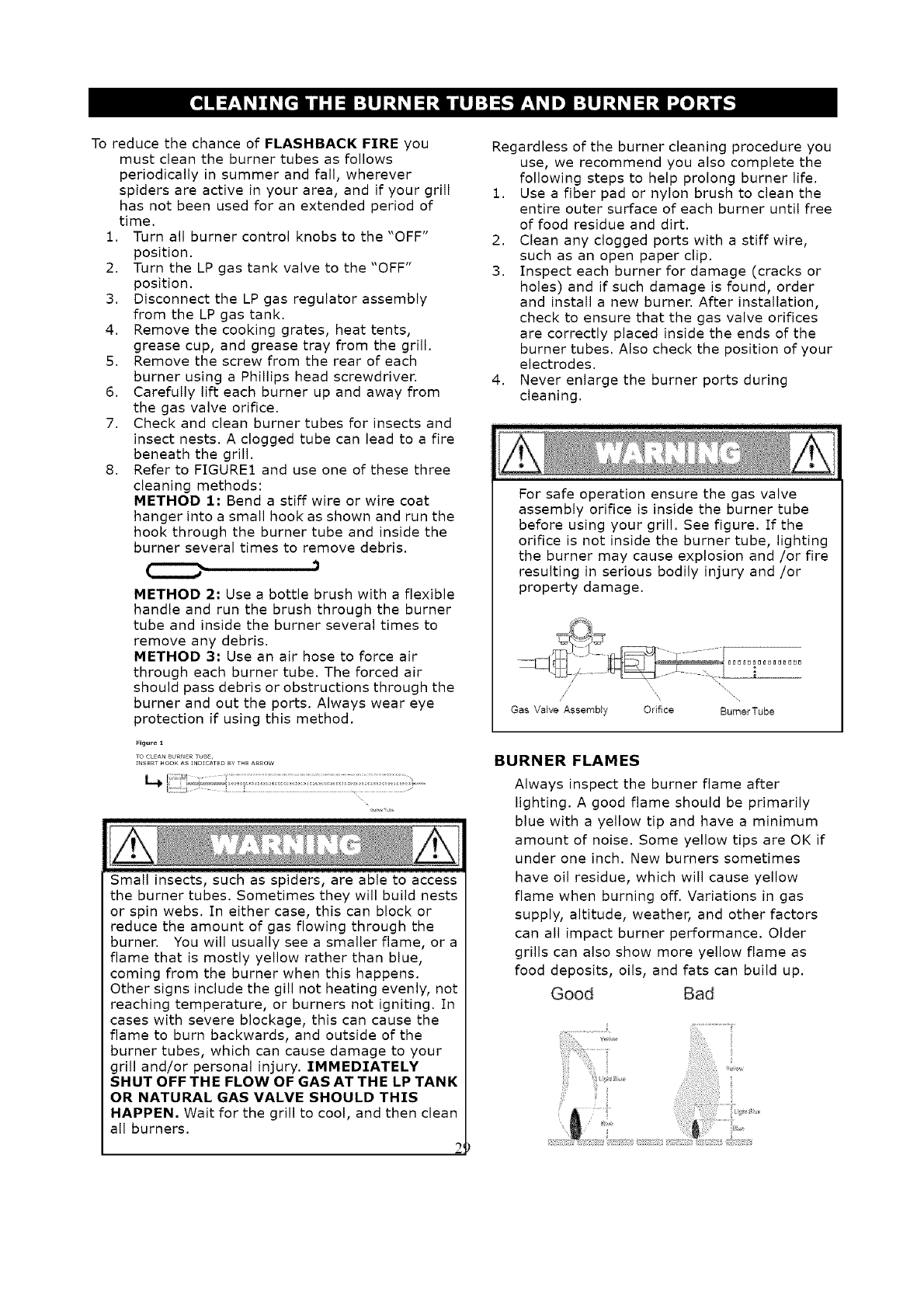Special offers from our partners!

Find Replacement BBQ Parts for 20,308 Models. Repair your BBQ today.

To reduce the chance of FLASHBACK FIRE you
must clean the burner tubes as follows
periodically in summer and fall, wherever
spiders are active in your area, and if your grill
has not been used for an extended period of
time.
I. Turn all burner control knobs to the "OFF"
position.
2. Turn the LP gas tank valve to the "OFF"
position.
3. Disconnect the LP gas regulator assembly
from the LP gas tank.
4. Remove the cooking grates, heat tents,
grease cup, and grease tray from the grill.
5. Remove the screw from the rear of each
burner using a Phillips head screwdriver.
6. Carefully lift each burner up and away from
the gas valve orifice.
7. Check and clean burner tubes for insects and
insect nests. A clogged tube can lead to a fire
beneath the grill.
8. Refer to FIGURE1 and use one of these three
cleaning methods:
METHOD 1: Bend a stiff wire or wire coat
hanger into a small hook as shown and run the
hook through the burner tube and inside the
burner several times to remove debris.
METHOD 2: Use a bottle brush with a flexible
handle and run the brush through the burner
tube and inside the burner several times to
remove any debris.
METHOD 3: Use an air hose to force air
through each burner tube. The forced air
should pass debris or obstructions through the
burner and out the ports. Always wear eye
protection if using this method.
Figure 1
TOCtEAN _U_NE_ TUSE,
rNSE_T HOO_ AS INDICATED BYTHE A_OW
Small insects, such as spiders, are able to access
the burner tubes. Sometimes they will build nests
or spin webs. In either case, this can block or
reduce the amount of gas flowing through the
burner. You will usually see a smaller flame, or a
flame that is mostly yellow rather than blue,
coming from the burner when this happens.
Other signs include the gill not heating evenly, not
reaching temperature, or burners not igniting. In
cases with severe blockage, this can cause the
flame to burn backwards, and outside of the
burner tubes, which can cause damage to your
grill and/or personal injury. IMMEDIATELY
SHUT OFF THE FLOW OF GAS AT THE LP TANK
OR NATURAL GAS VALVE SHOULD THIS
HAPPEN, Wait for the grill to cool, and then clean
all burners.
2
Regardless of the burner cleaning procedure you
use, we recommend you also complete the
following steps to help prolong burner life.
1. Use a fiber pad or nylon brush to clean the
entire outer surface of each burner until free
of food residue and dirt.
2. Clean any clogged ports with a stiff wire,
such as an open paper clip.
3. Inspect each burner for damage (cracks or
holes) and if such damage is found, order
and install a new burner. After installation,
check to ensure that the gas valve orifices
are correctly placed inside the ends of the
burner tubes. Also check the position of your
electrodes.
4. Never enlarge the burner ports during
cleaning.
For safe operation ensure the gas valve
assembly orifice is inside the burner tube
before using your grill. See figure. If the
orifice is not inside the burner tube, lighting
the burner may cause explosion and/or fire
resulting in serious bodily injury and/or
property damage.
Gas Valve Assembly Orifice BumerTube
BURNER FLAMES
Always inspect the burner flame after
lighting. A good flame should be primarily
blue with a yellow tip and have a minimum
amount of noise. Some yellow tips are OK if
under one inch. New burners sometimes
have oil residue, which will cause yellow
flame when burning off. Variations in gas
supply, altitude, weather, and other factors
can all impact burner performance. Older
grills can also show more yellow flame as
food deposits, oils, and fats can build up.
Good Bad


















